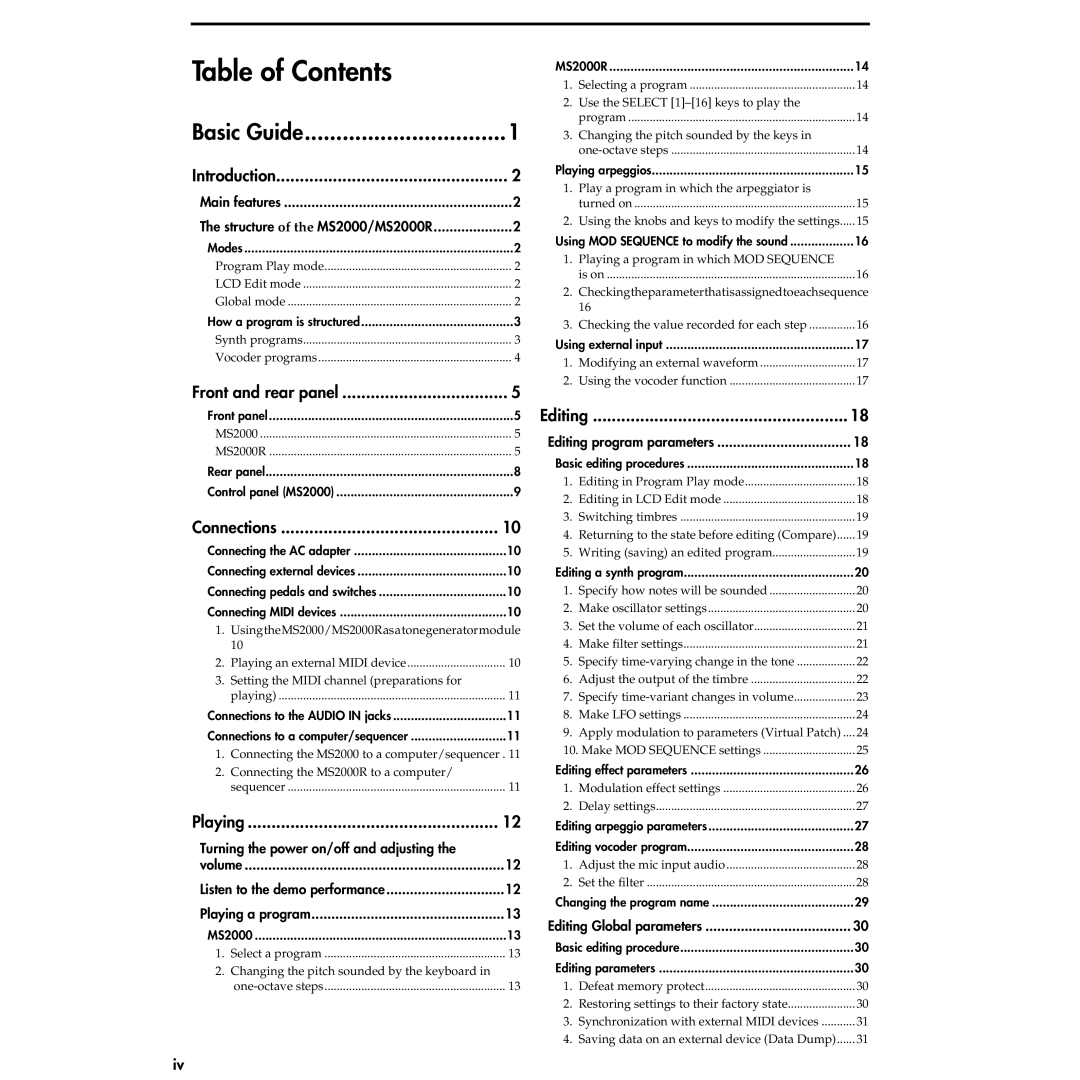Table of Contents |
|
Basic Guide | 1 |
Introduction | 2 |
Main features | 2 |
The structure of the MS2000/MS2000R | 2 |
Modes | 2 |
Program Play mode | 2 |
LCD Edit mode | 2 |
Global mode | 2 |
How a program is structured | 3 |
Synth programs | 3 |
Vocoder programs | 4 |
Front and rear panel | 5 |
Front panel | 5 |
MS2000 | 5 |
MS2000R | 5 |
Rear panel | 8 |
Control panel (MS2000) | 9 |
Connections | 10 |
Connecting the AC adapter | 10 |
Connecting external devices | 10 |
Connecting pedals and switches | 10 |
Connecting MIDI devices | 10 |
1.UsingtheMS2000/MS2000Rasatonegeneratormodule
10
2. | Playing an external MIDI device | 10 |
3. | Setting the MIDI channel (preparations for |
|
| playing) | 11 |
Connections to the AUDIO IN jacks | 11 | |
Connections to a computer/sequencer | 11 | |
1.Connecting the MS2000 to a computer/sequencer . 11
2.Connecting the MS2000R to a computer/
sequencer | 11 |
Playing | 12 |
Turning the power on/off and adjusting the |
|
volume | 12 |
Listen to the demo performance | 12 |
Playing a program | 13 |
MS2000 | 13 |
1. Select a program | 13 |
2. Changing the pitch sounded by the keyboard in |
|
13 |
MS2000R | 14 | |
1. | Selecting a program | 14 |
2. | Use the SELECT |
|
| program | 14 |
3. | Changing the pitch sounded by the keys in |
|
| 14 | |
Playing arpeggios | 15 | |
1. | Play a program in which the arpeggiator is |
|
| turned on | 15 |
2. | Using the knobs and keys to modify the settings | 15 |
Using MOD SEQUENCE to modify the sound | 16 | |
1. | Playing a program in which MOD SEQUENCE |
|
| is on | 16 |
2.Checkingtheparameterthatisassignedtoeachsequence 16
3. | Checking the value recorded for each step | 16 |
Using external input | 17 | |
1. | Modifying an external waveform | 17 |
2. | Using the vocoder function | 17 |
Editing | 18 | |
Editing program parameters | 18 | |
Basic editing procedures | 18 | |
1. | Editing in Program Play mode | 18 |
2. | Editing in LCD Edit mode | 18 |
3. | Switching timbres | 19 |
4. | Returning to the state before editing (Compare) | 19 |
5. | Writing (saving) an edited program | 19 |
Editing a synth program | 20 | |
1. | Specify how notes will be sounded | 20 |
2. | Make oscillator settings | 20 |
3. | Set the volume of each oscillator | 21 |
4. | Make filter settings | 21 |
5. | Specify | 22 |
6. | Adjust the output of the timbre | 22 |
7. | Specify | 23 |
8. | Make LFO settings | 24 |
9. | Apply modulation to parameters (Virtual Patch) .... | 24 |
10. Make MOD SEQUENCE settings | 25 | |
Editing effect parameters | 26 | |
1. | Modulation effect settings | 26 |
2. | Delay settings | 27 |
Editing arpeggio parameters | 27 | |
Editing vocoder program | 28 | |
1. | Adjust the mic input audio | 28 |
2. | Set the filter | 28 |
Changing the program name | 29 | |
Editing Global parameters | 30 | |
Basic editing procedure | 30 | |
Editing parameters | 30 | |
1. | Defeat memory protect | 30 |
2. | Restoring settings to their factory state | 30 |
3. | Synchronization with external MIDI devices | 31 |
4. | Saving data on an external device (Data Dump) | 31 |
iv
